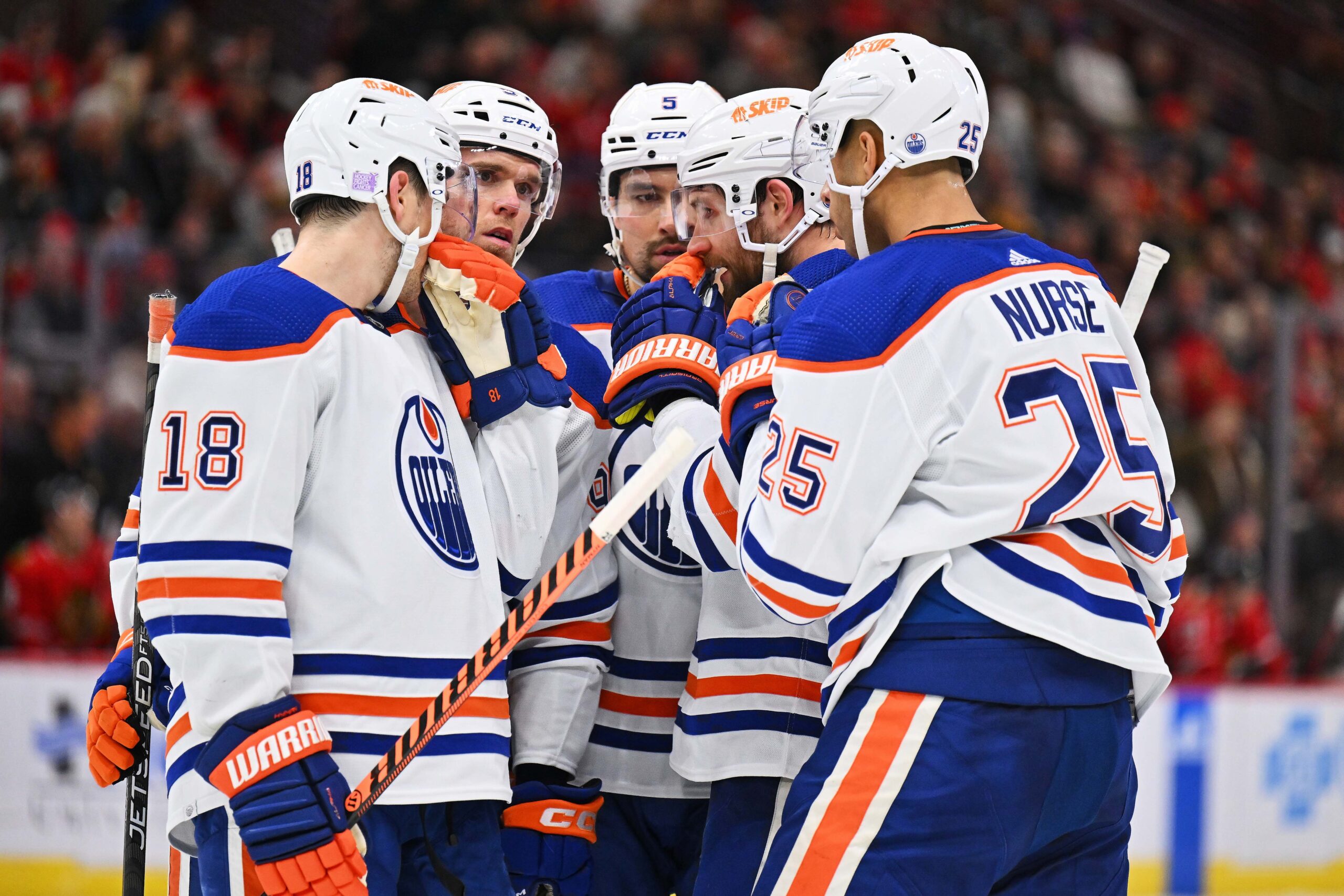The Edmonton Oilers forced themselves back into the forefront of the hockey universe in the 2023-24 NHL season with an appearance in the final. They fell just short of doing what only one other team in history has done before. Only the 1942 Toronto Maple Leafs have ever come back to win the Stanley Cup after falling behind three games to none. The Oilers legendary playoff performance will live in the memories of Oilers’ fans for years to come. But how did the team get there? Not just this season, this Cup final. How did the Edmonton Oilers come into existence in the first place? What was the long and winding road that took them to the 2024 Stanley Cup Final?
The Edmonton Oilers History from Birth to the 2024 NHL Stanley Cup Final
The most important name in Edmonton Oilers history isn’t Wayne Gretzy, Mark Messier or Glenn Anderson. It’s not Connor McDavid, Leon Draisaitl or Grant Fuhr. The most important name in Edmonton Oilers history is William Dickenson Hunter. Without “Wild Bill” Hunter, there simply would be no Edmonton Oilers.
Why Wild Bill?
Bill Hunter was involved with the major-junior hockey club, the Edmonton Oil Kings. Known for his larger-than-life presence, he was never shy about expressing his opinions or promoting his ideas. His promotional tactics were often unconventional and attention-grabbing. They helped build strong fan bases and increase the visibility of his teams. Hunter was determined to bring professional hockey to Edmonton.
The Founding of the WHA
In 1971, Hunter became one of the co-founders of the World Hockey Association (WHA). It was to be a new professional hockey league, intended to rival the NHL. The WHA aimed to bring professional hockey to markets that the NHL had overlooked, offering an alternative for both players and fans alike.
Using his strong local connections and persuasive skills, he rallied support from Edmonton’s business community and hockey fans. Moreover, he positioned Edmonton as a viable and enthusiastic market for professional hockey. It was Hunter who convinced WHA officials of the city’s potential. Hunter organized the team’s operations. In addition, he secured financial backing for the team. He developed a competitive roster. Finally, his promotional efforts generated excitement around the new team. All of this was crucial to the Oilers initial success.
The WHA team played out of Edmonton, but called itself the Alberta Oilers. Calgary Flames fans will scoff at the notion that the Oilers ever belonged to Alberta as a whole. But widening Edmonton’s small population base and economic footprint to the entire province was a smart initial move.
The Original Oilers: Building the Team
Right from the start, fan support was strong. It was clear Edmonton, Alberta could support a professional hockey team.
| YEAR | ATTENDANCE |
| 1972-73 | 3,828 |
| 1973-74 | 4,429 |
| 1974-75 | 10,722 |
| 1975-76 | 7,931 |
| 1976-77 | 8,370 |
| 1977-78 | 10,235 |
| 1978-79 | 11,255 |
While the attendance figures above may seem low, it’s important to remember one thing. That one thing is that the Oilers played their first two seasons in an abysmal barn, the Gardens. The Gardens was built for actual livestock shows. Furthermore, the building opened in 1913 and seated just 5,200 people for hockey. During their seven years in the WHA, the Oilers achieved only a middling record, as shown in the table below.
| Games Played | Wins | Losses | Ties | Winning Percentage |
| 556 | 259 | 273 | 24 | .487
|
Adding Strong Players
Hunter recruited players by leveraging the WHA’s willingness to offer higher salaries and more freedom to players when compared to what the NHL offered. This approach attracted notable talent to the Oilers. Prominent NHL players that Hunter enticed into playing for his upstart team included Al Hamilton, Eddie Joyal, Jim Harrison, Doug Barrie, Cowboy Bill Flett and “Rusty” Patenaude. They would later be joined by Norm Ullman, Brett Callighen, Ron Chipperfield, Dave Dryden, Barry Long, Blair MacDonald, Mike Rogers, and Stan Weir. And a very young, 17-year-old, Wayne Gretzky.
Did the Oilers Really Win Gretzky in a Backgammon Game?
Gretzky began his professional career in the WHA with the Indianapolis Racers in 1978. The Racers, however, faced severe financial difficulties. Owner Nelson Skalbania decided to sell Gretzky’s contract after he played just eight games for the Racers. He sold Gretzky, Eddie Mio and Peter Driscoll’s contracts to Peter Pocklington, the owner of the Edmonton Oilers, for $850,000. The transaction was straightforward. Skalbania needed to offload assets due to the Racers’ financial struggles. Conversely, Pocklington seized the opportunity to acquire a young phenom in Gretzky.
Urban legend holds that Gretzky came to the Oilers as a result of a bet in a backgammon game between Skalbania and Pocklington. No one really knows if the backgammon story is true or not. What’s true is that Pocklington had just gotten the world’s greatest ever player for his team. Acquiring Gretzky proved to be a transformative move for the Oilers. His presence elevated their profile and made them an enticing target for the merger with the NHL.
Merging With the NHL
Way before the 2024 Stanley Cup Final, the Edmonton Oilers joined the NHL as part of the NHL-WHA merger in 1979. In March 1979, the NHL Board of Governors approved a plan to merge with the WHA, bringing four WHA teams into the NHL. Those teams were the Edmonton Oilers, New England Whalers, Quebec Nordiques, and Winnipeg Jets. Two teams, the Cincinnati Stingers and Birmingham Bulls, unfortunately didn’t make the cut.
Terms of the merger included a fee of $6 million per team for the right to join the NHL and additional financial arrangements to compensate NHL teams for the territorial rights. The merger not only stabilized the professional hockey landscape, but also enriched the NHL with the inclusion of strong, competitive teams and star players like Gretzky.
Years later, and today, three of the WHA teams didn’t survive in their original cities. First, Winnipeg moved and became the Arizona Coyotes. Second, New England morphed into the Carolina Hurricanes. Third, the Nordiques moved and became the Colorado Avalanche. So, the Oilers are the only WHA team that survives intact to this day as an NHL team.
The NHL Reclamation Draft
As part of the merger agreement, NHL teams were allowed to reclaim players who had previously played in the NHL and were now in the WHA. However, each WHA team, including the Oilers, was allowed to protect a number of players to ensure they could remain competitive. The Oilers managed to keep Gretzky, Hamilton, Dryden, Callighen, and Mio from their WHA roster. They also kept Dave Semenko, who would ride shotgun for Gretzky as he dominated the league.
But You Build Through the Draft
The Oilers initial NHL draft success was phenomenal, adding a strong core that would dominate the league for years.
| 1979 | Mark Messier | Glenn Anderson | Kevin Lowe |
| 1980 | Paul Coffey | Jari Kurri | Andy Moog |
| 1981 | Grant Fuhr | Steve Smith | |
| 1983 | Esa Tikkanen |
That’s six Hall-of-Famers in three drafts. Not even including Gretzky, who was never drafted. The Oilers rapidly developed into a powerhouse. They dominated the NHL during the 1983–84 season, finishing first overall with a franchise record of 57 wins and 119 points. That year kick-started a string of five cups in seven years: ’84, ’85, ’87, ’88, and ’90 for the Edmonton Oilers and their dominance in the Stanley Cup Final.
Without that Legacy, Would the Team Have Survived the “Decade of Darkness?”
Poor ownership and hockey deals made simply to line the pockets of failing owner Pocklington stained the Oilers legacy. If karma awarded him Gretzky due to Skalbania’s financial difficulties, the wheel turned and Pocklington was soon selling his own hockey assets to try and rescue his businesses. First, Pocklington refused to meet Coffey’s new contract demands and sent him to the Pittsburgh Penguins in 1987. Then, what came in 1988 was even worse. In what came to be known in the hockey world as simply “the trade,” Gretzky was sold off to the Los Angeles Kings.
Next, we can look at how the 1991 season multiplied the pain. First, Messier was sent to the New York Rangers. Second, Kurri to the Philadelphia Flyers. Third and perhaps the final draw, Anderson and Fuhr were sent to the Toronto Maple Leafs.
The guts of arguably the greatest team in NHL history were gone. Fans were disgruntled. The team was rumoured to being moved several times. Just ask the Quebec Nordiques, Cleveland Barons, Kansas City Scouts, and Atlanta Flames how that turned out for their cities. Not one of them ever got back in the NHL again.
In 1998, Pocklington sold the Oilers to group of 38 local business owners and community leaders known as the Edmonton Investors Group (EIG). What is that old expression of too many cooks spoiling the broth? Especially when all they can afford to put in it is chopped cabbage and beets.
The Decade of Darkness
Then came the “decade of darkness.” The Oilers missed the playoffs ten consecutive years, from 2006-07 through to 2015-16. The team wasn’t just bad. It was very bad. Only twice did they manage over .500 seasons (2007-2008: 41-35-6 and 2008-2009: 38-35-9). Players bolted as soon as their contracts were finished. New players refused to consider signing with the team. Fans wore paper bags over their heads and threw their Oilers jerseys onto the ice in disgust.
The Turnaround
Consolidating ownership in 2008 was crucial to the Oilers turnaround. The EIG sold the team to Daryl Katz, a local billionaire. Financial stability was brought back in. But being that far down, for that long, meant a long road back. Things only really turned around when Leon Draisaitl (2014) and Connor McDavid (2015) were drafted by the Oilers. They went on to become two of the best players in the world nowadays. Finally, the team was back on track. In 2016-17, the team got to the second round of the playoffs. In 2019-20, they lost in the first round. The team had the same result in 2020-21. 2021-22 saw them get to the third round. On to the second round again in 2022-23. And, of course, an agonizingly close one goal from Stanley Cup glory in 2023-24.
The Long and Winding Road for the Edmonton Oilers Getting to the 2024 Final
As close as this year’s Stanley Cup series against the Panthers was, it was even closer that the Oilers almost ceased to exist multiple times on their five-decade journey there. The team was almost folded, moved or given up on multiple times. And none of it would have been possible without the dream of a junior hockey promoter called “Wild Bill” Hunter five decades ago.
Main photo: Jamie Sabau-USA TODAY Sports






